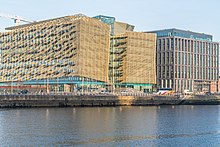 | |
 | |
| Headquarters |
|
|---|---|
| Established | 1 February 1943 |
| Ownership | 100% state ownership[1] |
| Governor | Gabriel Makhlouf (since September 2019) |
| Central bank of | Ireland |
| Reserves | 0.74 billion USD (2017)[1] |
| Preceded by | Currency Commission (currency control) Bank of Ireland (Government's banker)1 |
| Website | centralbank |
| 1 Even after establishment of the Central Bank, the Bank of Ireland remained the government's banker until 1 January 1972. 2 The Central Bank of Ireland still exists but many functions have been taken over by the ECB. | |
The Central Bank of Ireland (Irish: Banc Ceannais na hÉireann) is the Irish member of the Eurosystem and had been the monetary authority for Ireland from 1943 to 1998, issuing the Irish pound. It is also the country's main financial regulatory authority, and since 2014 has been Ireland's national competent authority within European Banking Supervision.[2]
The Central Bank of Ireland was founded on 1 February 1943, and since 1 January 1972 has been the banker of the Government of Ireland in accordance with the Central Bank Act 1971,[3] which can be seen in legislative terms as completing the long transition from a currency board to a fully functional central bank.[4]
Its head office, the Central Bank of Ireland building, was located on Dame Street, Dublin from 1979 until 2017.[5] Its offices at Iveagh Court and College Green also closed down at the same time. Since March 2017, its headquarters are located on North Wall Quay, where the public may exchange non-current Irish coinage and currency (both pre- and post-decimalization) for Euros, as well as high value Euro banknotes and "mutilated" currency.[6] It also operates from premises at nearby Spencer Dock. The Currency Centre (Irish Mint) at Sandyford is the currency manufacture, warehouse and distribution site of the bank.[7]
- ^ a b Weidner, Jan (2017). The Organisation and Structure of Central Banks (Thesis). Technische Universität Darmstadt.
- ^ "National supervisors". ECB Banking Supervision. 29 December 2022.
- ^ "Central Bank Act, 1971". Irishstatutebook.ie. 28 July 1971. Retrieved 21 April 2012.
- ^ Previously the commercial Bank of Ireland, established in 1783, had been the government's banker.
- ^ "1980 – Central Bank of Ireland, Dame Street, Dublin". Archiseek. Archived from the original on 1 December 2010. Retrieved 10 April 2010.
- ^ "Central Bank of Ireland, Contact Us". Central Bank of Ireland. Retrieved 10 April 2017.
- ^ "Irish central bank sells old premises for €67 million". centralbanking.com. Central Banking Newsdesk. 17 January 2017. Retrieved 18 January 2017.